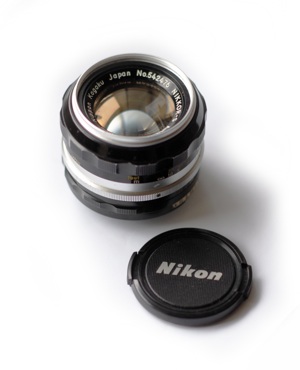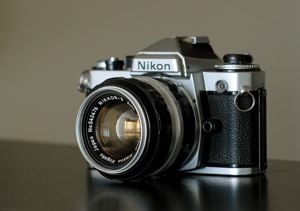Weekend of Nikon 80–200mm
I’m going to have a Nikon 80–200mm AF-D on my camera throughout the entire 3-day weekend we have here in the States, and will (hopefully) put photos up from it a couple of times, culminating with a review on Tuesday.
I’m going to have a Nikon 80–200mm AF-D on my camera throughout the entire 3-day weekend we have here in the States, and will (hopefully) put photos up from it a couple of times, culminating with a review on Tuesday.
Black and White film seems to have survived the digital era better than color print or slide. I imagine the image quality of B&W negatives that gives it its staying power has something to do with the logarithmic nature of film exposure combined with the high dynamic range possible vs. color print and slides (and digital, too). In any case, it’s not going away any time soon, especially not for medium format artistic photographers.
These photos are 35mm on Kodak TMax 400, scanned off my Plustek OpticFilm 7500i
I haven’t yet had time to clean up these scanned images, so there’s scratches and dust all over the place. Normally I use the scanner’s dust-reduction mode to get rid of it, but it misidentifies dust on many B&W negatives for some reason.
Though film grain is much more prevalent than noise in digital cameras, I think it has a nicer feeling to it, perhaps because it seems more randomized in pattern.
The first time I tried changing the aperture on a modern Canon SLR (a 20D) I was mystified. I tried turning all the knobs while on manual mode, and nothing would do it. I eventually broke down, got the manual, and learned the on/off switch in the back had to be moved past the “ON” position onto a line which pointed to the scroll wheel. Since that day, this behaviour confused me to no end. Why should the on/off switch not be turned to on when changing the aperture?
Looking at pictures of the new Canon EOS 7D, it finally dawned on me. The on/off switch has been moved, and where the “ON” switch once was is now labelled “lock”. The scroll wheel is too easy to accidentally move, so the old “ON” position functioned as a lock to prevent accidental changes. I probably should have realized this earlier, but I don’t use Canons often enough to have done so.
I still really don’t like this interface. For one thing it’s a needless extra switch, where as on Nikon bodies we just change another wheel with our forefinger, without chance for accidental input. The real issue, however, is for people like me who use their left eye in the viewfinder. This means the scroll wheel, which is on the right side of the camera body, gets jammed up against our faces. It’s just not a comfortable position from which to change the aperture.
Overall: 4 out of 5
Optics: 4
Price on Used Market: ~$50 USD
Value at $50 USD: 5
An old silver and black design, the Nikkor-C 50mm f/1.4 non-ai performs similarly to the current model. There is a later S·C version which added a red coating and reduced flaring.
Nikkor-S 50mm f/1.4 Non-AI
 Taken with Nikon 85mm f/1.4 AIS
Taken with Nikon 85mm f/1.4 AIS
Assorted Information
| Max Aperture | f/1.4 |
| Min Aperture | f/16 |
| Aperture Blades | 7 |
| Close Focus | 0.6m/2ft |
| Filter Thread | 52mm |
| Hard Infinity Stop? | Yes |
| Built in Hood? | no |
Image Quality
The Nikkor-S like the the 50mm f/1.4 AF-D has an aperture with 7 straight blades, while the 50mm f/1.4 AF-S has 9 rounded blades.
Boke is good, but with some highlighting around edges which can make backgrounds look slightly busier. The lens also suffers from significant coma when wide-open. Otherwise it’s a bit soft at 1.4, good on DX crops for portraits, but sharpens up by f/2.8 and remains so through f/8.
Operation
The focusing ring is metal, not rubber, and turns smoothly almost 1/2 way around the barrel, which I think is a good distance for 50mm. Filters will not turn with focusing, but it’s not an IF design, so the front does move a couple millimeters from close focus at .6m/2ft to infinity. My only real complaint is the metal is colder to the touch in winter than rubber would be. Otherwise I quite like the feel of it.
Grand Central Clock — Nikon D700 (full frame) & S·C Version
Full Frame
Noticeable but correctable vignetting is present from at f/1.4 to f/2.8.
Compared to...
My bunny Thor poses for the 50mm s·c non-ai, and the Nikkor 50mm f/1.4 AF-D on a full frame D700.
AF-D @f/1.4
Non-AI @f/1.4
As you can see from the thumbnails here, the AF version has some, but less vignetting.
100% crops
Not too much difference, the AF-D (bottom) has slightly better contrast at f/1.4, but the difference disappears by f/2. If I have time, I’ll put up some samples. Also, Thor didn’t seem to want to keep his eyes all the way open for the non-ai lens.
Which is which? Give up? The top is the AF version, bottom is the non-ai. A couple generations didn’t really do much to image quality. The AF version does focus a bit closer, is lighter, and autofocuses, but it feels cheaper, especially the focus ring.
Taken @f/1.4
Final Word
50mm is an especially interesting focal length now, because it’s uses are fairly different on Full Frame and APS-C cropped cameras. On full frame cameras it’s the old standby normal lens, versatile, and famously all Henri Cartier-Bresson ever really needed. On a DX cropped sensor it becomes a 75mm equivalent short tele, good for portraits.
A 50mm f/1.4 is a lens everyone should probably own, and this is a great manual focus choice. It’s a complete steal for $50. The only problem is most of the copies you’ll see are not AI’D, which means they won’t work on any but the cheapest SLRs Nikon sells today without conversion. The good news is the modern version’s aren’t expensive either, and are great as well. This is a great lens to get for an old MF body that will take non-ai lenses, but there’s not much reason to skip the 50mm f/1.4 AFS.
More Photos with this Lens
All images with a DX Crop except those marked with a film type.
Taken @f/1.4
Automated Tellers — Nikon D700 (full frame) & S·C Version
Portrait @f/1.4
Taken on Nikon FE & Fuji Velvia 50
Taken on Kodak TMax 400
Taken on Nikon FE & Fuji Velvia 50
Taken @f/1.4
Taken on Nikon FE & Fuji Velvia 50
Taken on Nikon FE & Fuji Reala 100
More Photos of this Lens
This lens looks at home on my Nikon FE
 Taken with Nikon 85mm f/1.4 AIS
Taken with Nikon 85mm f/1.4 AIS
note, the original version of this review erroneously state the -S designation was for aperture blade count rather than glass element count. I apologize for the error.
I bought a used Nikon 180mm f/2.8 AIS which just came in yesterday. I didn’t get a chance to go out with it then, but today I took a jaunt around Bryant Park with it to put it through its paces.
I don’t own any other lens that looks nearly this beat up on the outside, but the glass looks brand new — without a scratch. Unfortunately, the focusing ring is stiff, not particularly surprising on something this worn.
Wishing for a better viewfinder at this point, fine manual focus control can be difficult on modern cameras wide open. This is a bit front-focused, but I couldn’t tell until afterwards.
I couldn’t pass by a girl with a Hasselblad without taking a photo. I hope her shot worked out.
The lens is certainly sharp enough at f/2.8, but there’s definite chromatic aberration here.
I like the lens so far, the poor person’s 200mm f/2, you can get a decently shallow depth of field from some distance. It should prove more useful on full frame, too once I get to using it with film or get a full frame digital.